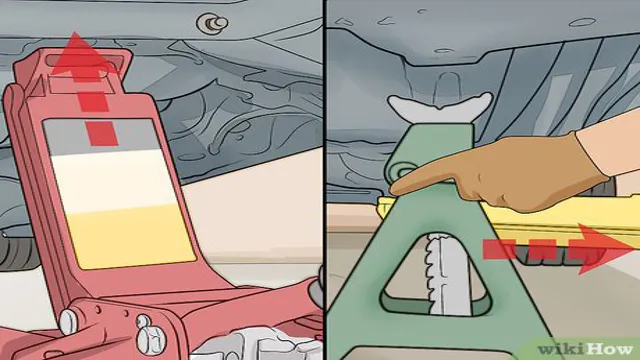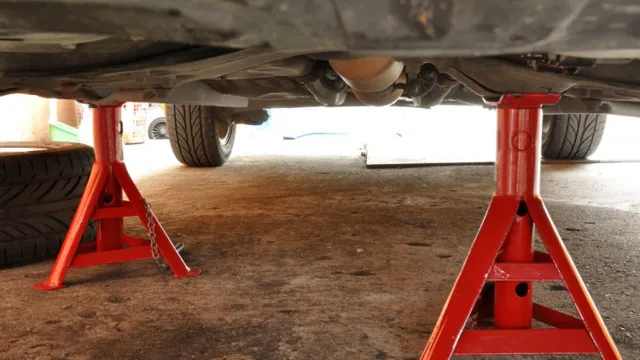Where Do I Place Jack Stands – A Comprehensive Guide for Safe and Secure Lifting

Placing your car on a jack stand before performing any repairs or maintenance is extremely important for your safety. But, where do you place the jack stand? It can be a bit confusing, especially for those who are new to DIY car maintenance. The truth is, there are specific places you should place your jack stand to ensure its stability and safety.
Just like your car has a foundation that supports everything on top of it, a jack stand serves as the support structure for your car. In this blog post, we’ll dive deeper into where to place jack stands and why it matters so much for your safety and your car’s longevity. So, let’s explore the ins and outs of where to place jack stands for maximum stability and safety.
Introduction
When it comes to working on cars, safety should always come first. This includes using jack stands correctly. But the question remains, where do I place jack stands? The answer is simple: always check your vehicle’s owner manual for specific instructions.
Every car model and make is different, so it’s important to take the time to read through the manual and find the recommended jack stand placement points. Often, you’ll find that manufacturers suggest placing the stand beneath the frame or on designated jacking points. These points are usually marked on the underside of your vehicle.
It’s important to make sure you’re using the correct jack stand placement points to prevent damage to your vehicle and ensure safety while working. Remember, taking the time to follow manufacturer guidelines can prevent accidents and save lives.
Explanation about Jack Stands
Jack stands are an essential tool for any mechanic, DIY enthusiast or anyone who wants to work safely under a vehicle. These inexpensive devices can be used in conjunction with a floor jack to provide a safe and reliable way to lift and hold a car or truck off the ground. Jack stands are made from heavy-duty materials and come in a variety of sizes and weight capacities, making it important to choose the right one for the job.
They work by supporting the weight of the vehicle on the frame or suspension, allowing the wheels to be removed or other maintenance to be performed. It is important to note that jack stands should always be used on a level surface and not placed on soft or uneven ground. Using jack stands is a crucial safety measure that can prevent accidents or injuries from occurring when working on a vehicle.

Importance of using Jack Stands
Jack stands are an essential safety tool that every car owner should have in their garage. If you are someone who enjoys working on cars, then you should know the importance of using jack stands when lifting your vehicle. Most car owners tend to rely on their car jacks alone, but this is a dangerous mistake that can lead to serious injury or even death.
Jack stands provide a sturdy and secure foundation for your car to rest on, which greatly reduces the risk of accidents. Using a jack stand is not only a safety measure, but it also makes working on your car easier and more efficient. So, it is crucial to invest in a good set of jack stands if you want to ensure the safety of yourself and your car.
Finding Suitable Spots for Jack Stands
When it comes to using jack stands, one of the most important considerations is where to place them. The location you choose can have a big impact on your safety and the effectiveness of the stands. Generally, you should look for spots on your vehicle’s frame or structural components that are sturdy and capable of supporting the weight of your vehicle.
This might include the jacking points specified in your owner’s manual, or other areas with reinforced metal. You should also take care to avoid placing stands on components that could be crushed or otherwise damaged during the lifting process, such as exhaust pipes or suspension components. Always inspect the area carefully and make sure the stands are securely in place before beginning any work on your vehicle.
By taking the time to find suitable spots for your jack stands, you can ensure a safe and successful DIY repair or maintenance project.
Locating Jack Points on the Car
When it comes to changing a tire or performing maintenance under a car, it’s essential to ensure that the car is stable and secure. That’s where jack stands come in handy, but locating the appropriate jack points on the car can be tricky. Finding suitable spots for jack stands depends on the type of car you have and the specific model.
Some vehicles have pre-designated lift points that are marked in your car’s owner manual or on the underside of the vehicle. If you can’t locate these markings, examine your car’s undercarriage for flat sections of metal that can support the weight of the vehicle. Avoid using suspension components or brake lines as support points, as they can easily bend or break under the pressure of the car’s weight.
Once you’ve found the ideal jack points, place the jack stands securely under them to provide a reliable and safe workspace. With a little bit of effort, you’ll have no trouble finding the perfect spots to place your jack stands and accomplish your task efficiently.
Using the Owner’s Manual as Reference
When it comes to using the owner’s manual as a reference for finding suitable spots for jack stands, there are a few things to keep in mind. First and foremost, always make sure to consult the manual specific to your vehicle make and model. The owner’s manual will provide detailed instructions on where to place the jack stands safely without damaging any components of the car.
Additionally, it’s crucial to engage the parking brake and ensure the car is in park or in gear, as this will prevent the vehicle from moving while on the jack stands. Remember, safety should always come first when working on your car. By following the guidelines provided in your owner’s manual, you can ensure that the jack stands are positioned correctly, and you can work on your vehicle with confidence.
Considering the Type of Surface
When it comes to finding suitable spots for jack stands, it’s crucial to consider the type of surface you’re placing them on. If the surface is soft or uneven, the jack stand may sink or become unstable, posing a danger to both you and your vehicle. On the other hand, if the surface is too hard, the jack stand may not have sufficient grip to hold the weight of the vehicle.
The best surface for jack stands is a flat and level one, such as a concrete garage floor. However, if you’re working outdoors or on terrain other than flat concrete, you can use a plywood board as a base for the jack stand to provide a stable and even surface. A little bit of extra effort to find the right spot for your jack stands can make all the difference in ensuring your safety and avoiding any incidents.
So, always check the surface before you place the jack stands for maximum safety and peace of mind.
Placing & Using Jack Stands Safely
“Where do I place jack stands?” is a frequently asked question by many DIY car enthusiasts. Placing jack stands properly is extremely important to ensure safety while working under a vehicle. The ideal location to place a jack stand is on a flat surface, preferably concrete, and on a solid part of the vehicle’s frame.
Avoid placing the jack stand on a sloped, uneven surface, or any part of the vehicle that is not strong enough to support its weight. It’s crucial to always use jack stands in pairs and place them on opposite sides of the vehicle. Additionally, lifting the vehicle with a hydraulic jack before placing the jack stands is essential to avoid any accident while working.
Always double-check the weight capacity of the jack stand and make sure it can support the weight of the vehicle you are working on. By following these tips, you can ensure that you are placing and using jack stands safely and securely.
Step by Step Instructions
Placing and using Jack Stands safely is a crucial aspect of any DIY project that involves raising a vehicle off the ground. To get started, park your car on a flat, level surface, and set the emergency brake. Locate the recommended jacking points in your vehicle’s owner manual and position the hydraulic jack under it.
Slowly jack up the car and place the jack stand under it, ensuring it is resting on a sturdy and stable surface. Repeat the process on the other side of the vehicle, and double-check the stability of both of the stands. Once you are sure that the car is securely supported by the jack stands, carefully lower the car onto them.
Always make sure that you are using the right weight rating of the jack stands and never exceed the specified limit. Keep in mind that the jack stands must be positioned at the recommended jacking points and that you should never work under a vehicle supported only by a hydraulic jack. Remember, your safety is essential, and nothing is more important than taking the necessary precautions to ensure it.
Precautionary Measures
When it comes to working on a vehicle, safety should always be the number one priority. This is particularly true when using jack stands to support the vehicle during maintenance or repairs. To ensure that you’re using jack stands safely, always start by choosing the right location.
A flat, stable surface is best to prevent any shifting or tipping. Before using the jack stands, check them thoroughly for any signs of damage or wear, including cracks or rust. Next, place the stands at the correct jacking points on the vehicle, typically indicated in your vehicle owner’s manual.
Once the stands are in place, you can safely raise the car off the ground using a hydraulic jack, making sure to use the jack stands to support the weight of the car, rather than the jack itself. Remember, never work under a vehicle that’s only supported by a jack – always use jack stands to prevent accidents or injuries.
Conclusion
In the end, the question of where to place Jack stands is not just about safety – it’s also about balance and equilibrium. Just like in life, finding the right spot to rest and support yourself can make all the difference. So take a moment to think strategically, pick a solid and stable foundation, and raise yourself up with confidence.
And always remember, just like with Jack stands, it’s better to be safe and secure than sorry and shaky.”
FAQs
1. How do I determine the proper placement for jack stands on my vehicle? A: Consult your car owner’s manual for information on designated lift points. If the manual is not available, look for reinforced areas of the vehicle’s undercarriage or frame where it is safe to place jack stands. 2. What is the weight capacity of jack stands? A: The weight capacity can vary depending on the manufacturer, but most jack stands have a weight capacity of 2 to 10 tons. 3. Can I use jack stands on a sloped surface? A: It is not recommended to use jack stands on a sloped surface as it can cause the vehicle to shift or topple. Always use jack stands on a level surface. 4. How do I properly secure a vehicle on jack stands? A: After positioning the jack stands, ensure that they are firmly in place and that the vehicle is stable before getting under it. Use wheel chocks on the remaining tires to prevent any movement. 5. Is it safe to use just one jack stand? A: No, it is not safe to use just one jack stand. Always use at least two jack stands to ensure stability and prevent the vehicle from tipping over. 6. Can I lift my car with a floor jack and then use jack stands? A: Yes, it is recommended to use a floor jack to lift the vehicle and then use jack stands to support it. 7. How often should I replace my jack stands? A: It is recommended to replace jack stands every 5 years or sooner if they show signs of wear or damage. Always inspect jack stands before each use.



